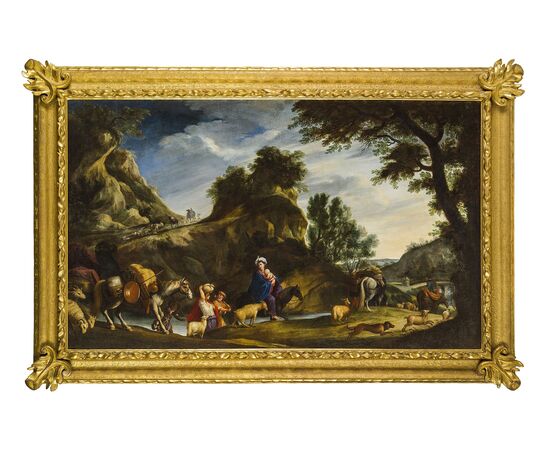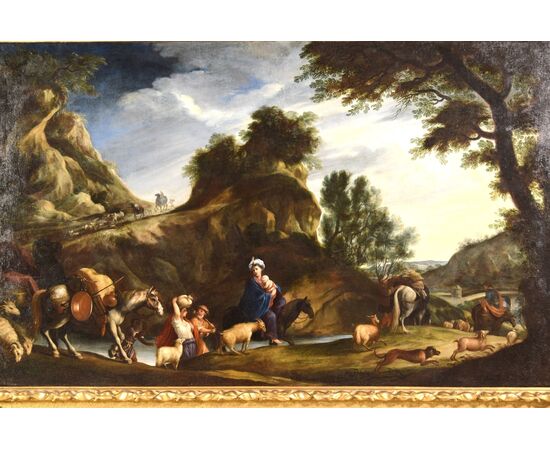Pier Francesco Cittadini, Jacob and his family travel to Egypt, 17th century
Pier Francesco Cittadini (Milan, 1616 – Bologna, 1681)
Jacob and his family travel to Egypt
Oil on canvas, 109 x 190 cm (canvas only). Frame L 214 x 145 x 10
Price upon request
Item accompanied by a certificate of authenticity and historical-artistic expertise (link at the bottom of the page)
The valuable painting, made in oil on canvas, depicts Jacob and his family traveling to Egypt, and we believe it can be, given the high pictorial quality, an autograph work by Pier Francesco Cittadini (Milan, 1616 – Bologna, 1681) made after 1647. The work, in excellent condition, is accompanied by a coeval frame in finely carved and gilded wood.
The scene depicted, which in the past was confused with the Flight into Egypt, should instead be identified with the biblical episode of Jacob's journey. In the foreground, reading the painting from left to right, we observe a caravan composed of animals, including donkeys, dromedaries, goats, dogs and horses, and people, women, men and slaves, who laden with goods continue their journey along the banks of a river, following a path that, towards the right, seems to lead to crossing a small bridge. Beyond the watercourse, an environment characterized by large rocks is described, which reach far away, covering the entire verticality of the canvas. On the left, in the distance, we see the tail of the caravan traveling the steep path. Large trees liven up and harmonize the environment, just as white and gray clouds characterize the predominantly clear sky, illuminated on the right by sunlight.
The story is told in the Bible, Book of Genesis, 30, 25, a passage in which Jacob's flight from Carran is described after the disagreements with Laban, his wife Rachel's father.
Jacob is the third great patriarch of the Bible. The twelve tribes of the people of Israel originate from his descent. He is the son of Isaac and Rebecca, who urged him to flee from Esau's wrath to Carran to find refuge with his brother, Laban. At his uncle's house, Jacob met his daughter Rachel. As soon as he saw his cousin, Jacob was conquered by her. Jacob will stay seven years in Laban's service to marry his beloved Rachel. But Laban, with a deception, will give him in marriage first Leah, the less beautiful older daughter, and only after another seven years the splendid Rachel. From his first wife he will have several children, while Rachel will give birth to his favorite son, Joseph, who will become viceroy of Egypt.
After years of service, Jacob asked to be paid with every dark-colored head among the sheep and every spotted and speckled head among the goats. Laban agreed and had all heads of that kind removed by his sons. So Jacob took fresh poplar, almond and plane tree branches, peeled them and put them in the watering troughs. The optical suggestion induced the goats and sheep to conceive and give birth to dark, striped and speckled heads. He also ensured that all the stronger and healthier heads of Laban's flock drank near the peeled branches, thus ensuring a genetic superiority to his part of the flock. His flocks grew numerous and strong and he became richer than his relative, arousing his envy. It was clear that Laban would not respect him for much longer. At the suggestion of the Lord, Jacob decided to return to Canaan. Trying to avoid any possible dispute, he left with his family while Laban was absent for the shearing of the sheep. But when, three days later, his uncle returned home, he was furious, feeling offended because Jacob had left secretly and had not allowed him to greet his daughters and grandchildren. Moreover, his teraphim, the statuettes, or idols, representing the family divinities, had disappeared. After 7 days of pursuit, Laban and his men reached Jacob's group on Mount Gilead, in the mountainous region west of the Euphrates River, where uncle and nephew had a stormy conversation. The younger man was indignant to hear himself accused of stealing the idols and told Laban to search at will in the tents of his family. Neither of them could in fact know or even imagine that it was Rachel who had taken the idols and hidden them in the camel's saddle. During the search, she sat determined on the saddle, apologizing for not being able to get up, "because I have what usually happens to women" (Gen 31:35). Thus the stolen goods were not discovered.
The author of the work subject of this study was inspired for the composition by the print of an etching by Stefano Della Bella (1610/ 1664) of around 1647. The etching by Stefano della Bella bears the title "Iacob sur ses vieux jours quitte sans fascherie pour voir son filz Ioseph, sa terre et sa patrie" and is signed at the bottom left "Stef. della Bella In. et fe.", while on the right it is declared "Cum privil. Regis", that is, with the king's license. Stefano Della Bella (Florence, 18 May 1610 – Florence, 12 July 1664) was born into a family of painters, sculptors and goldsmiths and, having become an orphan of his father, a sculptor, at an early age, he dedicated himself first to the art of goldsmithing at the school of Giovanni Benedetto Castiglione and Gasparo Mola, then directing his attention to drawing and engraving. Soon he began to draw figures and copy the etchings of Jacques Callot, which inspired his youthful works. Under the protection of the Medici, in particular of Don Lorenzo, the younger son of Grand Duke Ferdinando I, Della Bella had the opportunity to make study trips to Rome, where he stayed from 1633 to '36; in Rome he met French engravers and print publishers such as Israël Henriet and François Langlois, who greatly influenced his decision to move to Paris in 1639, four years after Callot's death. In Paris he soon achieved both worldly success, thanks to the engravings commissioned by Cardinal Richelieu; he frequented courtiers, theater artists and writers, while refusing honors that were too oppressive. In 1646-47 his travels continued, in Holland, Amsterdam, Antwerp and Dordrecht. Returning to Florence in 1650, he resumed working under the protection of the Medici court, working for his patrons. In 1656 he became a member of the Accademia degli Apatisti.
The painting under study is reasonably attributable to Pier Francesco Cittadini, or Pierfrancesco Cittadini, known as il Milanese or il Franceschino (Milan, 1616 – Bologna, 1681) as some exemplary stylistic comparisons proposed below can demonstrate. Pier Francesco Cittadini was an Italian Baroque painter, mainly active in Bologna. His artistic training took place first with the painter Daniele Crespi; then in about 1634 he moved to Bologna, where he followed the teachings of Guido Reni. He then moved to Rome, where he obtained commissions also from Louis XIV, thanks above all to the success achieved with his still lifes and landscapes.
In 1650, he returned to Bologna, where on June 19, 1653 he married Giulia Ballarini, from whom he had numerous children and of whom at least three, Carlo Antonio, Angelo Michele, Giovanni Battista, would follow in the footsteps of their father. His works are preserved in important museums and collections such as villa Estense di Sassuolo, Bologna, coll. Giovannini, Galleria Estense di Modena, Pinacoteca civica di Bologna, Galleria nazionale d'arte antica di Trieste, Pinacoteca civica di Forlì.
The painting in question, of high pictorial quality, certainly belongs to the corpus of important works by the artist, in which we find depicted the female figure with the turban that the painter often likes to include in his canvases.
Observing the setting of the canvas in question and the description of the landscape, the rocky reliefs and the games of the several perspective levels, it is possible to propose some similar layouts, in which there are also subjects that lend themselves to a similar description, such as caravans of wayfarers and herds or the "Return from Egypt" of the Pushkin Museum.
Also interesting is a ink drawing by Cittadini, preserved at the Royal Collection Trust, in which a study for a landscape seems very close to the one then depicted in the canvas, with trees acting as wings to the scene, large rocky reliefs arranged in a manner very similar to the definitive version. It is understood that for Cittadini there is an authentic feeling for the landscape, felt as a protagonist not secondary to the figures.
In conclusion, the work, in good condition, is attributable to Pier Francesco Cittadini and datable following Stefano della Bella's engraving of 1647, probably made after the artist's return to Bologna (1650). The canvas is therefore added to the corpus of works by a representative painter in the development of Baroque painting, especially the Bolognese one.
Carlotta Venegoni




